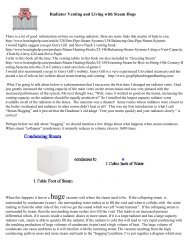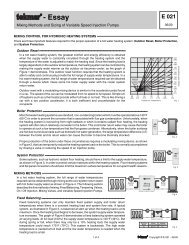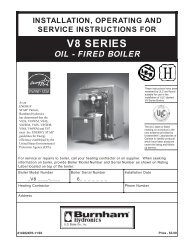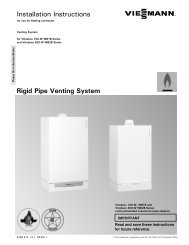Steam Locomotive Firebox Explosion on the Gettysburg Railroad ...
Steam Locomotive Firebox Explosion on the Gettysburg Railroad ...
Steam Locomotive Firebox Explosion on the Gettysburg Railroad ...
You also want an ePaper? Increase the reach of your titles
YUMPU automatically turns print PDFs into web optimized ePapers that Google loves.
ANALYSIS<br />
General<br />
The phenomen<strong>on</strong> of crownsheet failure<br />
has been well known and understood for<br />
many years. That such a failure had occurred<br />
in this accident was evident from <strong>the</strong> start of<br />
<strong>the</strong> investigati<strong>on</strong>. All parties to <strong>the</strong><br />
investigati<strong>on</strong> agreed that <strong>the</strong> nature of <strong>the</strong><br />
damage, <strong>the</strong> statements of <strong>the</strong> locomotive<br />
crew, and <strong>the</strong> postaccident examinati<strong>on</strong> of<br />
<strong>the</strong> boiler c<strong>on</strong>firmed that <strong>the</strong> crownsheet<br />
failure was due to low water. The Safety<br />
Board <strong>the</strong>refore c<strong>on</strong>cludes that <strong>the</strong> explosi<strong>on</strong><br />
in locomotive 1278 resulted from crownsheet<br />
failure caused by having too little<br />
water in <strong>the</strong> boiler.<br />
The investigators found that it was not a<br />
single event or c<strong>on</strong>diti<strong>on</strong> that caused <strong>the</strong><br />
water to be too low. It was too low because<br />
of <strong>the</strong> cumulative result of a number of<br />
steam-locomotive boiler-maintenance and<br />
operati<strong>on</strong>al factors that resulted from a lack<br />
of training, knowledge, and applicati<strong>on</strong>. The<br />
following is a brief synopsis of <strong>the</strong> accident<br />
chr<strong>on</strong>ology and <strong>the</strong> inherent factors<br />
involved. Each of <strong>the</strong>se factors will be<br />
explained in greater detail in <strong>the</strong> rest of <strong>the</strong><br />
analysis.<br />
The events leading to <strong>the</strong> crownsheet<br />
failure began when <strong>the</strong> locomotive stopped<br />
at Wolf Pit to pick up <strong>the</strong> helper. There, <strong>the</strong><br />
first fireman shut off <strong>the</strong> feed pump, thus<br />
preventing any water from entering <strong>the</strong><br />
boiler. He turned off <strong>the</strong> feed pump because<br />
a <strong>on</strong>e-way check valve between <strong>the</strong> feed<br />
pump and <strong>the</strong> boiler was leaking to <strong>the</strong><br />
extent that he believed that <strong>the</strong> locomotive’s<br />
drivers (wheels) might slip <strong>on</strong> <strong>the</strong> rail. The<br />
feed pump remained off for about <strong>the</strong> next<br />
10 minutes as <strong>the</strong> train climbed <strong>the</strong> grade<br />
until <strong>the</strong> sec<strong>on</strong>d fireman took over at <strong>the</strong> top<br />
of <strong>the</strong> grade, near Gardners. The distance<br />
between <strong>the</strong> start of <strong>the</strong> grade and Gardners<br />
was about 2 miles; and according to <strong>the</strong><br />
engineer, while <strong>the</strong> train was going up <strong>the</strong><br />
grade, it was “working hard,” using more<br />
steam and, c<strong>on</strong>sequently, more water than<br />
usual. The first fireman said that as steam<br />
was used during <strong>the</strong> ascent, <strong>the</strong> pressure in<br />
<strong>the</strong> boiler dropped from about 230 psi to 175<br />
psi. The firemen were unc<strong>on</strong>cerned about<br />
<strong>the</strong> drop in pressure because <strong>the</strong>y assumed<br />
that <strong>the</strong> water glass would warn <strong>the</strong>m if <strong>the</strong><br />
level of water in <strong>the</strong> boiler became<br />
dangerously low, thus allowing <strong>the</strong>m to<br />
correct <strong>the</strong> problem.<br />
Even before <strong>the</strong> water was cut off, its<br />
level had been purposely kept low as a<br />
matter of standard operating procedure. The<br />
engineer told Safety Board investigators that<br />
he normally kept <strong>the</strong> level of water so low<br />
that <strong>the</strong> water glass was <strong>on</strong>ly 1/3 to 1/2 full<br />
even while <strong>the</strong> train ascended <strong>the</strong> grade to<br />
Gardners. The sec<strong>on</strong>d fireman testified that<br />
<strong>the</strong> highest water-glass level that he<br />
remembered was “3/4 at most with<br />
fluctuati<strong>on</strong>.” The engineer said that keeping<br />
<strong>the</strong> water low in <strong>the</strong> boiler was a way of<br />
minimizing <strong>the</strong> chance of water entering <strong>the</strong><br />
cylinders (working water). He also said that<br />
having less water in <strong>the</strong> boiler made for<br />
“good steaming,” or <strong>the</strong> rapid creati<strong>on</strong> of <strong>the</strong><br />
steam that <strong>the</strong> train needed to climb <strong>the</strong><br />
grade to Gardners. However, keeping <strong>the</strong><br />
water so low reduced <strong>the</strong> layer of safety over<br />
<strong>the</strong> vulnerable crownsheet, particularly as<br />
<strong>the</strong> water level changed with changes in<br />
grade and terrain.<br />
39
















